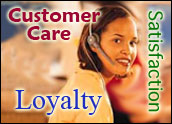
Despite the enormous popularity of peer-to-peer social networking, the adoption cycle for branded online communities has been relatively slow. That a growing number of consumer brands are transforming their existing static Web sites into interactive online communities is a trend that is not only recent, but also rapidly accelerating.
The proven business value of these communities and various changes in media consumption behavior are persuading major companies that their future success depends to some degree on their ability to create and mobilize their own online customer communities. The global economic recession has also played a role, by putting more pressure than ever on companies to minimize marketing waste and maximize return on marketing investment.
Today, companies can select from a number of private label, Software as a Service platforms as the basis for enabling online community features and functionality, as well as for managing customer activity and performance reporting.
These platforms, from leading vendors like MarketTools, Jive, Lithium, Passenger, Neighborhood America, Communispace, Powered and Igloo Software, integrate technologies designed to drive traffic, enhance the customer experience and monetize customer relationships.
The platforms may also include social media monitoring and data analysis tools to identify key influencers, understand consumer sentiment, and glean actionable insights from the online conversations that are taking place about the brand on an ongoing basis.
Treating Customers as Codevelopers
One of the key benefits of branded online communities relates to the idea of treating customers as cocreators or codevelopers. With the advent of social networking, companies can further automate and expand their efforts to involve customers in the innovation process. For most companies, innovation is the only sustainable competitive advantage; hence, the importance of opening a window onto the unmet wants and needs of customers — and even soliciting their direct input into the ideation of future products and services.
Beyond fueling continuous innovation, customer input into the ideation process provides some assurance of sufficient market demand once the new product or service becomes available. Many companies have enjoyed considerable success in this area, engaging their online communities in such a way that they become an additional voice into the product development lifecycle.
Consider Motorola, which has longed viewed its customers as codevelopers. In December 2008, Motorola launched an online community platform, developed by Igloo Software, to facilitate conversation and support the specific needs of its Enterprise Mobility Systems customers. The customer user groups include the Trunked User Group, for public safety employees who use two-way radio systems, the Mutual User Group, which serves the needs of utility workers, and the Mobile Data User Group.
Members of these user groups previously came together once or twice a year in face-to-face meetings to discuss issues related to their mobile communications systems, according to Connie Allen, consultant events manager on the global marketing team. Once the meetings concluded, the issues tended to go into a black hole, simply because it was difficult to sustain the conversation and facilitate the necessary follow-up.
“They sometimes got angry because there were so many issues and they thought Motorola wasn’t listening to them,” recalled Allen. “It became imperative to show that we were listening to them.”
Motorola devised a report card to track issues and demonstrate progress. The problem was communicating the results. “We were using an internal tool that was atrocious,” said Allen. “It was built for purchasing, not for social networking. What we needed was a simple, barebones platform where both customers and Motorola could communicate outside of our face-to-face meetings. That was really the main intent.”
The platform, which currently has about 1,100 active customers, has evolved into a long-term solution that serves as a virtual home outside of user group meetings. Although still in its infancy, the online community has already exceeded expectations in terms of benefits.
“It enables customer-to-customer thought sharing, as well as Motorola-to-customer and customer-to-Motorola thought sharing,” said Allen, noting that it also drives employee productivity. “Time and cost savings are huge benefits.”
Of course, the main goal of the user groups is to keep customers loyal to Motorola so that they won’t entertain competitive bids for the multimillion dollar systems. At the same time, the platform facilitates cross-sell activity, simply by virtue of having the different user groups colocated on the same platform. Users of two-way voice radio communications are being exposed to products related to broadband wireless networks, for example. A customer may stumble across a promotion for mobile data terminals and start thinking about using data systems for, say, license plate recognition.
Users are increasingly using the platform to post the minutes from their own technical meetings and to explore ideas they want Motorola to pursue. Motorola views the consumer-generated content as an indispensable guide for new product development road maps. “The online community gives us input into what customers are going to want in the pipeline five years from now,” said Allen.
Driving Better (and Faster) Market Research
Traditional research methodologies may never completely supplant the need for traditional focus groups and research panels. That said, facilitating and monitoring social interaction in online communities can certainly drive greater efficiency in the process. In addition to being able to realize market research cost savings, companies can leverage branded online communities to dramatically reduce the amount of time required to gain consumer insights compared to traditional research methodologies. This, too, reduces related expenditures and resource allocation requirements.
Take the case of Sage. “Our beta testers are using our online community platform to provide feedback on upcoming releases,” said Kim Josephs, director of online communities. “We used to collect feedback on a weekly basis. Now it’s pretty much immediate. The discussion boards are closely monitored, and testers can engage directly with our engineering and product management staff.”
The platform, developed by Lithium Technologies, has been a huge success in terms of cost reduction, according to Josephs. “The resources that it takes to manage the entire process are significantly less,” she said, noting that the reduced time that it takes to get the information back to the team is a huge advantage because it allows the company to respond to issues very quickly.
“Not only does it allow us to bring issues to the attention of engineering the same day they get communicated,” said Josephs, “but we can also sometimes resolve the issues and roll the changes back out to the participants for testing the same day, as well. As a result, we’re able to get a lot more testing done during the four-to-five-week beta period. And the feedback is higher quality. Because of the ease of getting involved, our beta registration has increased dramatically. The last beta was up 300 percent in terms of participation. We’re confident that all this participation will translate into earlier product adoption for upgrades.”
Ongoing analysis of consumer-generated content can produce a vast array of strategic options, from insights into what content should be developed to what partnership opportunities should be pursued in order to maintain social currency. The insights can be used to enhance and inform a company’s positioning, to extend its strengths and capabilities, and to drive more rapid product innovation. Companies might even uncover questions to ask customers they might not otherwise have thought to ask.
Mobilizing Customers to Share Their Brand-Related Experiences
Using branded online communities to enhance customer experience quality and to identify and respond to the key drivers of customer satisfaction naturally leads to an increased volume of positive word-of-mouth referrals. For most companies, no marketing lever is more efficient and effective than customer advocacy, especially given the declining value of traditional marketing channels. Companies use a variety metrics, including likelihood-to-recommend scores such as the Net Promoter Score (NPS), to track and measure year-over-year improvement in customer advocacy and to try to understand the extent to which customer recommendations are influencing other consumers’ purchase decisions.
A good measure of influence is whether people are willing to talk broadly about a brand experience and inspire others to take action — not only in terms of a buying decision but also in terms of engaging their own personal networks. Members of an online community naturally spend more time interacting with the brand, and they are likely to share their brand-related experiences more frequently than before they joined the online community.
Eastman Kodak is a good example. Having founded the company in 1892, the renowned inventor George Eastman coined the advertising slogan, “You press the button, we do the rest.” The philosophical underpinnings of that slogan are today being applied in the context of Kodak’s online communities, according to Jeffrey Hazlett, Kodak’s chief business officer.
“We want to make things as simple and easy for our customers as possible,” he said. “We’re not going to inundate them with a million emails or make them answer a million questions. We just want them to go out, be creative and have fun.”
To help deliver a customer experience that embodies that spirit, Kodak in May 2007 launched the Idea Center, an online community powered by Neighborhood America, where members share ideas on how to create personalized gifts and other creative projects using their digital photos. Members make recommendations, talk about their experiences, and rank and rate ideas contributed by others.
Kodak’s overall approach to online communities can be best summed up in what Hayzlett calls the Four E’s: engage, educate, excite and evangelize. The Idea Center touches on all four in that it not only helps inspire consumers with creative project ideas but also motivates them to interact and, ultimately, become customer advocates. “The customers go out and do the work for us,” Hayzlett said. “It’s the power of the crowd.”
The Idea Center is part of the Kodak Gallery, which ranks as the company’s largest online community, with over 74 million members, and was launched in response to customer demand. “We found that customers were continually asking, “How do I do this or that with my digital pictures?” said Hayzlett. “This was a way for us to reach out and touch customers in ways that we never thought we could.”
Investing in the initiative was easy to justify for Kodak, and the business benefits have been even greater than expected. “The online community was very popular amongst our target audience from the start,” said Hayzlett. “We saw an immediate lift in customer conversion, and the average order volume for that part of the site.” In fact, Kodak reported that up to 25 percent of the site’s visitors purchase Kodak products directly through the community, and that the order size averages 50 percent larger, no doubt owing to the value of peer-to-peer recommendations.
“The ultimate measure of success is how far we’ve moved the needle both in terms of customer satisfaction and sales revenue,” said Hayzlett.
There are a lot of effective measurement tools like Net Promoter Score, he noted, “but you also just need to use common sense. If you’re engaged with your customers in the community, you see what they’re saying. I don’t need a lot of fancy measuring tools to tell me if it’s a good idea or a bad idea. My customers will tell me.”
Kodak is currently in the process of combining the Kodak Gallery Idea Center with its Kodak.com Tips and Project center. The goal, said Hayzlett, is simple. “We want to help our customers further release their creative spirit and at the same time help them preserve their memories in really unique ways.”
Kodak’s biggest brand attribute is trust, according to Hayzlett. “People have trusted us in helping to make their memories for lifetimes,” he said. “We’ve preserved those memories on paper. Now it’s a digital world, but people still want to interact with a company they can trust. When it comes to storing, saving and preserving memories, people look to Kodak. They think of us immediately. The key for us is to extend that trust to a whole new generation. Online communities like the Idea Center help us to do that.”
Giving Customers a Seat at the Strategy Table
Industry practitioners share a similar view of what makes for a successful online community. Their view is that communities are successful when companies build them for their customers rather than to merely achieve a specific set of business objectives. “If you go into this saying ‘this is what I need for the company,’ then you’re probably not going to be successful,” said one online community director. “But if you build this so your customers can have real conversations, then you have an opportunity to foster brand affinity and shape the future of the company.”
Beyond a compelling design and easy-to-use platform, companies need to find and execute the right customer value proposition. They need to continuously ask the question: If I were a target member, would I join and would I participate? If companies are unable to answer that question in the affirmative — and commit to implementing the resources to build a community that will enhance the customer experience on an ongoing basis — then they would be well-advised to reassess the viability of the initiative.
At its best, a branded online community should create a compelling bonding experience between customers and the brand. It should drive additional brand affinity and shape the future of the brand. As more companies are discovering, there’s enormous value to be gained by giving customers a seat at the strategy table and a sense of ownership of the ideas that are being implemented.
Jeff Zabin is a research fellow in customer management technologies at the Aberdeen Group.





















































A very good article that wraps up basic principles why companies in the future will have to engage with social media.
"The idea of treating customers as cocreators or codevelopers" is a basic principle of social media. Customers identify themselves with the brand and want to be able to influence the brands they like.
As Motorola’s Connie Allen states "It became imperative to show that we were listening to them." This is indeed the key issue when it comes to the use of social media and especially with branded social network communities. Customers want to be taken seriously! If not, social media also enables customers to make sure their anger is heard.
The reason why communities are successful is, "when companies build them for their customers". This is a basic step many companies tend to fail to make.
Branded communities need not be very large as they are directed at a niche and specific topic and not at masses like facebook.
So in the future we will see many more branded social network communities establish themselves in their niches.
By the way your list of leading vendors like MarketTools, Jive, Lithium, Passenger, Neighborhood America, Communispace, Powered and Igloo Software, is only limited to US companies. relenet is based in Germany and is a also leading provider of social network community software.